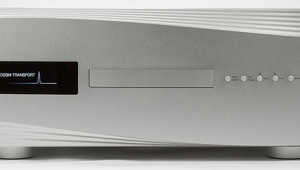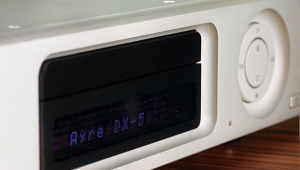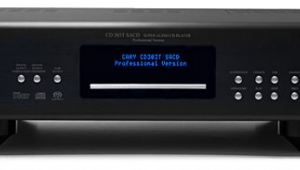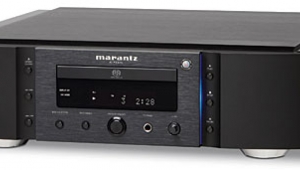| Columns Retired Columns & Blogs |
Alesis MasterLink ML-9600 Hard Disk/CD-R Recorder Page 2
What It Is
Because it was conceived as a studio component, the Alesis MasterLink ML-9600 offers both balanced and unbalanced analog and digital inputs and outputs. Because I was conceived as a tweaky audiophile, I used only the unbalanced analog inputs and outputs—not that there's anything wrong with the balanced. There is no Analog Input level adjustment, but there are 15dB of headroom from nominal input to clipping (+19dBu from the +4dBu balanced input, +5dBV at the -10dBV RCA input). I never ran into any distortion problems, though some phono front-end combos looked as if they were moving the meters to the next time zone. The ML-9600 is equipped with 24-bit, 128x oversampling A/D and D/A converters.
Footnote 1: Following the publication of the review, an anonymous reader e-mail us to let us know that while there is nothing in the manual regarding how to erase the entire hard drive, this can be done by, with the machine off, simultaneously pressing the "Power Switch", the "Create CD Button," and the "Utility Button".—John Atkinson
Because it was conceived as a studio component, the Alesis MasterLink ML-9600 offers both balanced and unbalanced analog and digital inputs and outputs. Because I was conceived as a tweaky audiophile, I used only the unbalanced analog inputs and outputs—not that there's anything wrong with the balanced. There is no Analog Input level adjustment, but there are 15dB of headroom from nominal input to clipping (+19dBu from the +4dBu balanced input, +5dBV at the -10dBV RCA input). I never ran into any distortion problems, though some phono front-end combos looked as if they were moving the meters to the next time zone. The ML-9600 is equipped with 24-bit, 128x oversampling A/D and D/A converters.
I'm not going to run you through the entire recording process or give you a roadmap to the complicated operating system, but I will say it's somewhat confusing for non-studio types. Though the instructions try valiantly to make using the ML-9600 simple, mathlexic me sometimes found it a ball of confusion. One of the most hilarious omissions in the instructions is a section titled "Erasing a Playlist." The instructions go on and on about how to record to and delete tracks from a Playlist, but I couldn't find anything about deleting an entire Playlist. I still don't know how to do it (footnote 1).
And let's say you decide you want to erase the whole damn hard drive and start over. On the last page of the manual, under "Utility Function," you'll find section 8.3: "Util3: HD Format." That's where you'll find out how to reformat the entire disc. Shouldn't instructions on erasing be located near instructions on recording? Yes. But they're not. Nor is the section where you do find out how to reformat a disc particularly well-labeled. The operating system is menu/cursor driven, so if you've programmed a home-theater receiver, you'll be in the driver's seat. But I've done that many times, and still found it difficult to see over the MasterLink's steering wheel.
The hard-drive software (upgradeable via the CD-R drive) divides the disk space into 16 Playlists, each of which can contain up to 99 tracks. The disk drive's total capacity depends on the recording resolution chosen. I recorded eight Roxy Music LPs at 24/96 and had hours of hi-rez space left over. The review sample contained a 4.3-gigabyte hard drive, but by the time you read this, a new production run of 20GB MasterLinks, with about 24 hours of standard CD recording time, should be in the pipeline. Apparently, upgrading the hard drive yourself is difficult and voids the warranty. Too bad.
The ML-9600's front panel, dominated by a large fluorescent display, is well-organized and easy on the eyes and fingers. Somewhat disappointing is the small, crowded, unlit remote and its inability to communicate with the MasterLink from more than a few degrees off-axis from the front panel's IR receptor. But considering the price and the performance, I'm not complaining.
Detailed Functionality & DSP Features
Just so you understand how versatile the MasterLink ML-9600 is, here's an in-depth look at some of the DSP functions. If you want to perform fade-ins or fade-outs, you have a choice of three "fade shapes" in either direction, all charted in the manual. You can change the gain of a track (over a very wide range) after it has been recorded. Gain adjustments are "nondestructive" edits and can be changed at any time after you've made them.
"Cropping" tracks (not reversible) is easy, and accomplished much as you'd edit reel-to-reel tape with a razor blade. At the push of a button you get an automatic five-second "roll forward" and "roll back" of the beginning and end of the track. By holding down the Track Start button and using the scan (<<>>) buttons you can rock the "tape" back and forth at slow speed until you reach the desired start and end points. When you're done, you'll hear a preview of your edit; if it's good, you can then Confirm the edit. While recording 22 Ella Fitzgerald 78s to a Playlist, sometimes I picked up the tonearm late, or started recording early. In a few minutes I was able to scrub the heads and tails of each track to create on the hard drive a really smooth-sounding compilation, which I've copied to CD-R for friends.
The four DSP functions—Compression, EQ, Look Ahead Peak Limiting, and Normalization—allow you to adjust a variety of parameters after you've made your recording. The compressor reduces dynamic range across the entire frequency range, and can be adjusted for Threshold, Ratio, Make Up Gain, Attack, Release, Key (which channel is used to control compression: left, right, or both), Knee (which affects how the compression behaves around the threshold you've chosen), and Detect (which lets you choose a peak or an average level for the threshold setting to be compared to. The Look Ahead peak limiter allows you to limit the highest peaks while raising the gain of the overall track so you can maximize the overall level.
Footnote 1: Following the publication of the review, an anonymous reader e-mail us to let us know that while there is nothing in the manual regarding how to erase the entire hard drive, this can be done by, with the machine off, simultaneously pressing the "Power Switch", the "Create CD Button," and the "Utility Button".—John Atkinson
- Log in or register to post comments




































